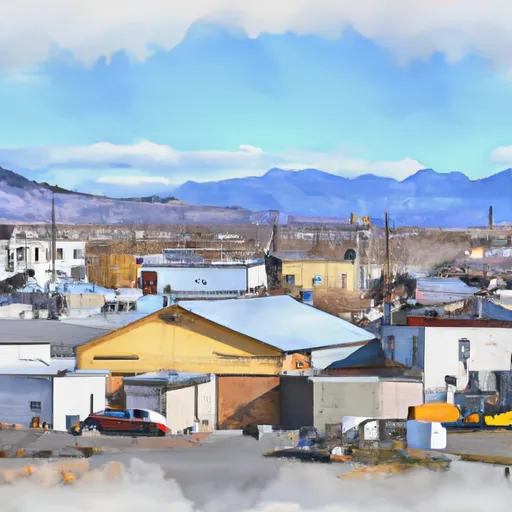-
 Snoflo Premium
Snoflo Premium
Get unlimited access to all our content
With no Ad interruptions! - Start Your Free Trial Login with existing account
Wadsworth
Eden Index
Climate
8.6
•
Recreation
2.2
•
Community
0.8
•
Safeguard
4.4/10

Wadsworth, Nevada is a small unincorporated community located in Washoe County. It experiences a semi-arid climate with hot, dry summers and cold winters. Summers can be scorching, with temperatures often exceeding 90°F, while winters are chilly, with average temperatures dropping below freezing.
Hydrologically, Wadsworth is situated near the Truckee River, which flows nearby and plays a crucial role in the region's water supply. The river provides opportunities for fishing, boating, and other water activities. Additionally, the area is known for its natural hot springs, which are a popular attraction for visitors and locals alike.
Outdoor recreation enthusiasts will find plenty of opportunities in and around Wadsworth. The nearby Pyramid Lake offers various recreational activities, including fishing for the famous Lahontan cutthroat trout. Hiking trails in the region provide opportunities to explore the beautiful desert landscape, with the chances to spot wildlife such as bighorn sheep and wild horses. Furthermore, the area is a haven for birdwatching, as it serves as a stopover for migratory birds.
Overall, Wadsworth, Nevada offers a diverse range of outdoor activities, beautiful natural scenery, and a unique blend of desert and river landscapes for visitors and residents to enjoy.
What is the Eden Index?
The Snoflo Eden Index serves as a comprehensive rating system for regions, evaluating their desirability through a holistic assessment of climate health, outdoor recreation opportunities, and natural disaster risk, acknowledging the profound impact of these factors on livability and well-being.
Climate Health Indicator (CHI): 8.6
Wadsworth receives approximately
153mm of rain per year,
with humidity levels near 63%
and air temperatures averaging around
12°C.
Wadsworth has a plant hardyness factor of
7, meaning
plants and agriculture in this region tend to thrive during the non-winter months.
By considering the ideal temperature range, reliable water supplies, clean air, and stable seasonal rain or snowpacks, the Climate Health Indicator (CHI) underscores the significance of a healthy climate as the foundation for quality living.
A healthy climate is paramount for ensuring a high quality of life and livability in a region, fostering both physical well-being and environmental harmony. This can be characterized by ideal temperatures, reliable access to water supplies, clean air, and consistent seasonal rain or snowpacks.
Weather Forecast
Streamflow Conditions
Truckee
Area Rivers
Truckee
Snowpack Depths
Truckee
Reservoir Storage Capacity
Truckee
Groundwater Levels
Recreational Opportunity Index (ROI): 2.2
The Recreational Opportunity Index (ROI) recognizes the value of outdoor recreational options, such as parks, hiking trails, camping sites, and fishing spots, while acknowledging that climate plays a pivotal role in ensuring the comfort and consistency of these experiences.
Access to outdoor recreational opportunities, encompassing activities such as parks, hiking, camping, and fishing, is crucial for overall well-being, and the climate plays a pivotal role in enabling and enhancing these experiences, ensuring that individuals can engage in nature-based activities comfortably and consistently.
Camping Areas
| Campground | Campsites | Reservations | Toilets | Showers | Elevation |
|---|---|---|---|---|---|
| Fort Churchill State Park | 20 | 4,252 ft | |||
| Lahontan Reservoir State Rec Area 1 | None | 4,185 ft | |||
| Silver Springs Beach - Lahotan State Park | 29 | 4,164 ft |
Nearby Ski Areas
Catastrophe Safeguard Index (CSI):
The Catastrophe Safeguard Index (CSI) recognizes that natural disaster risk, encompassing floods, fires, hurricanes, and tornadoes, can drastically affect safety and the overall appeal of an area.
The level of natural disaster risk in a region significantly affects safety and the overall livability, with climate change amplifying these risks by potentially increasing the frequency and intensity of events like floods, fires, hurricanes, and tornadoes, thereby posing substantial challenges to community resilience and well-being.
Community Resilience Indicator (CRI): 0.8
The Community Resilience Indicator (CRI) recognizes that education, healthcare, and socioeconomics are crucial to the well-being of a region. The CRI acknowledges the profound impact of these elements on residents' overall quality of life. By evaluating educational resources, healthcare accessibility, and economic inclusivity, the index captures the essential aspects that contribute to a thriving community, fostering resident satisfaction, equity, and social cohesion.

